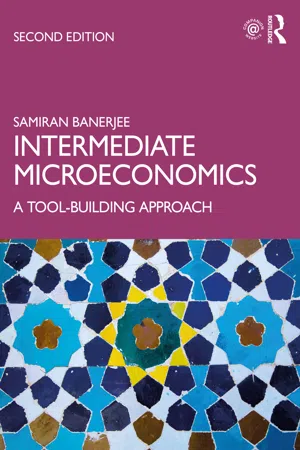
- 374 pages
- English
- PDF
- Available on iOS & Android
About this book
Intermediate Microeconomics: A Tool-Building Approach is a clear and concise calculus-based exposition of current microeconomic theory that is essential for students pursuing degrees in economics or business. The second edition explicitly incorporates constrained optimization techniques. This beautifully presented and accessible text covers all the essential topics typically required at the intermediate level, from consumer and producer theory to the market structures of perfect competition, monopoly, duopoly, and oligopoly. Other topics include general equilibrium, risk, and game theory, as well as chapters on externalities, asymmetric information, and public goods.
Through numerical examples as well as exercises, the book aims to teach microeconomic theory via a process of learning-by-doing. When there is a skill to be acquired, a list of steps outlining the procedure is provided, followed by an example to illustrate how this procedure is carried out. Once learned, students will be able to solve similar problems and be well on their way to mastering the skills needed for future study.
Intermediate Microeconomics presents a large amount of material in a concise way, without sacrificing rigor or clarity of exposition. Through use of this text, students will acquire both the analytical toolkit and theoretical foundation necessary in order to take upper-level field courses in economics, such as industrial organization, international trade, and public finance.
Frequently asked questions
- Essential is ideal for learners and professionals who enjoy exploring a wide range of subjects. Access the Essential Library with 800,000+ trusted titles and best-sellers across business, personal growth, and the humanities. Includes unlimited reading time and Standard Read Aloud voice.
- Complete: Perfect for advanced learners and researchers needing full, unrestricted access. Unlock 1.4M+ books across hundreds of subjects, including academic and specialized titles. The Complete Plan also includes advanced features like Premium Read Aloud and Research Assistant.
Please note we cannot support devices running on iOS 13 and Android 7 or earlier. Learn more about using the app.
Information

Table of contents
- Cover
- Half Title
- Title Page
- Copyright Page
- Dedication Page
- Contents
- Preface
- Acknowledgements
- 1 Markets
- 2 Budgets
- 3 Preferences
- 4 Individual Demands
- 5 Consumer Comparative Statics
- 6 Exchange Economies
- 7 Technology
- 8 Costs
- 9 Competitive Firms
- 10 Monopoly
- 11 Risk
- 12 Game Theory
- 13 Oligopoly
- 14 Externalities
- 15 Asymmetric Information
- 16 Public Goods
- Mathematical Appendix
- Selected Answers
- Index